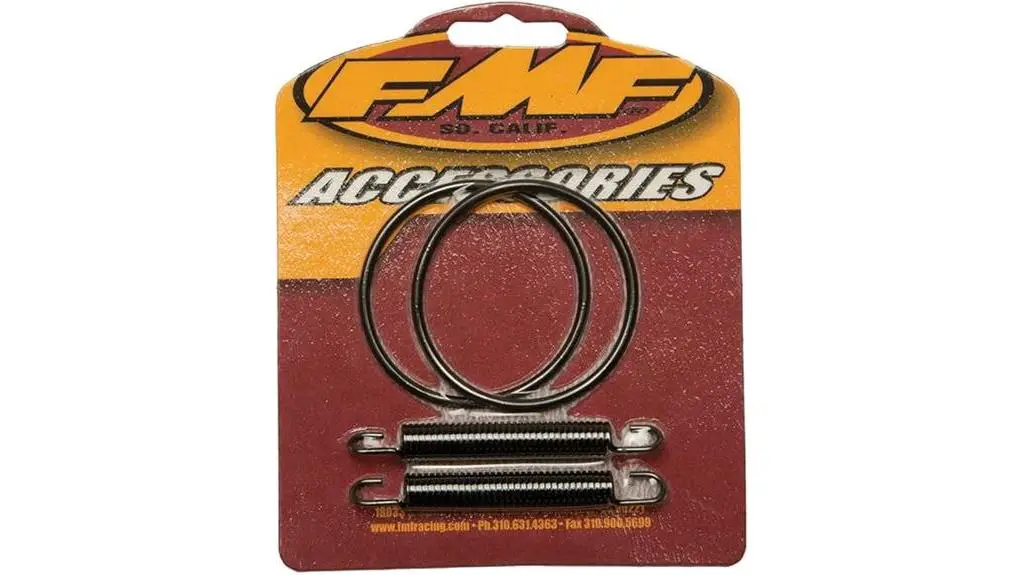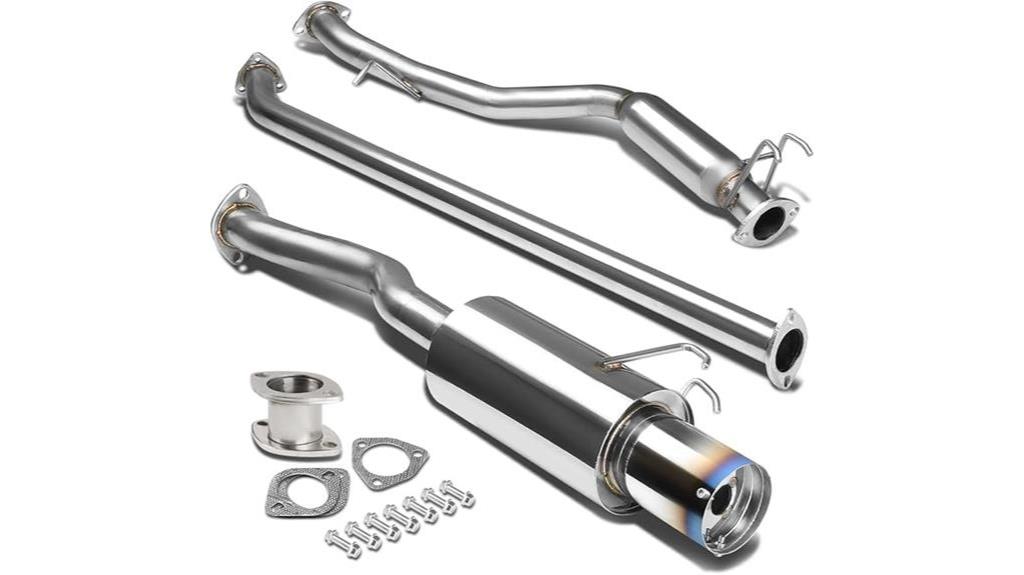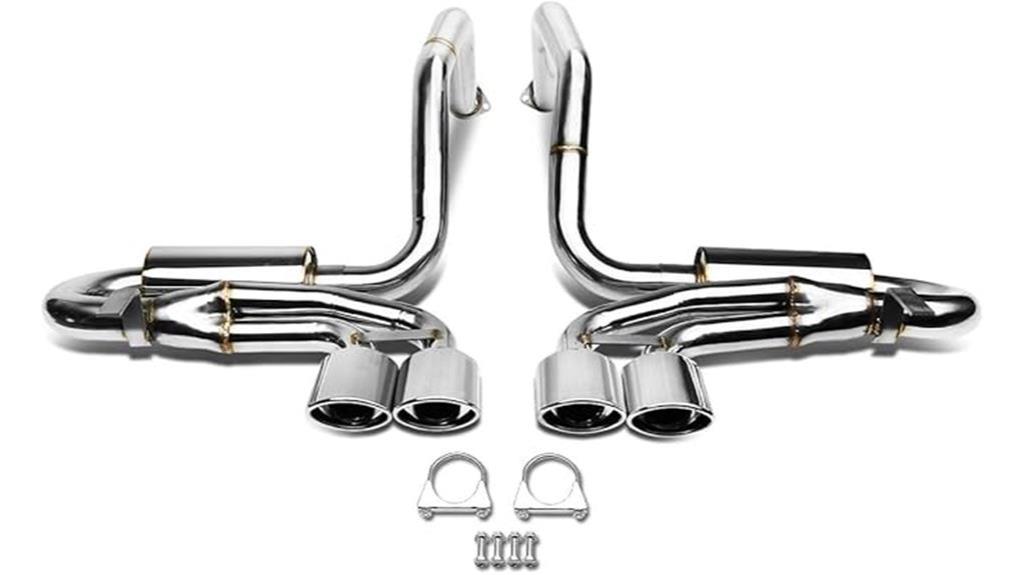Studies show that upgrading an exhaust system can yield performance gains of up to 10% for motocross bikes like the Yamaha YZ250F. With various options available, each exhaust system brings unique benefits that cater to different riding styles and preferences. The right choice can enhance not just power, but also torque and overall handling. As riders seek to maximize their machine's potential, understanding the best systems becomes vital for achieving peak performance. Which exhaust systems stand out in this competitive landscape, and what makes them essential for serious enthusiasts?
Quick Takeaways
- Upgrading to a high-quality exhaust system can increase horsepower by 15-25, enhancing overall bike performance.
- Look for exhaust systems specifically designed for your Yamaha YZ250F model year to ensure compatibility and proper fit.
- Choose materials like T-304 stainless steel for durability and superior corrosion resistance, which enhances longevity.
- Opt for dyno-tested systems to validate performance gains in horsepower and torque, ensuring you get the best value.
- Consider sound quality preferences; some riders enjoy a louder, more aggressive tone while others prefer quieter systems.
FMF Pipe O-Ring and Spring Kit for Yamaha YZ250 1999-2014 – 011318

If you're looking to upgrade your Yamaha YZ250 from 1999 to 2014, the FMF Pipe O-Ring and Spring Kit (part number 011318) is a must-have.
This kit fits perfectly with your two-stroke model and includes essential pipe O-rings and springs. Users rave about the springs providing just enough tension, preventing smoking at the header pipe.
If local shops can't help you find the parts, ordering online is the way to go. Installation is straightforward; use a hook device or a bent metal rod with a 3/4 wrench for the springs. Just avoid pliers, as they won't give you the leverage needed.
Overall, this kit's reliability and quality make it a top choice for enhancing your bike's performance.
Best For: This product is best for Yamaha YZ250 owners looking to enhance their bike's performance and reliability from 1999 to 2014.
Pros:
- Perfect fit for YZ250 models, ensuring effective performance.
- Easy installation with common tools, making it accessible for DIY enthusiasts.
- High-quality materials that prevent smoking at the header pipe and enhance durability.
Cons:
- Delivery time can be lengthy, taking almost 2 weeks for arrival.
- Limited local availability, requiring online purchases for most customers.
- Installation may require some creativity if specialty tools are not on hand.
DNA MOTORING Catback Exhaust System for Honda Civic EX/LX/DX (06-11)

The DNA MOTORING Catback Exhaust System is an excellent upgrade for Honda Civic EX/LX/DX models from 2006 to 2011, thanks to its high-quality T-304 stainless steel construction and performance enhancements.
With computerized mandrel bends and a TIG-welded CNC machine flange, it promises durability and style. You'll appreciate the 2.25-inch inlet and main piping, along with a sleek 4-inch round burnt muffler tip.
This system is dyno-proven to increase horsepower by 15-25, boosting your ride's performance. While installation might require some modifications, many users praise the deeper tone it produces.
Just note that feedback on noise levels varies, so consider your preferences before making a purchase. Overall, it's a solid choice for enhancing your Civic's exhaust system.
Best For: Enthusiasts looking to enhance the performance and sound of their 2006-2011 Honda Civic EX/LX/DX with a quality exhaust system.
Pros:
- High-quality T-304 stainless steel construction ensures durability and resistance to corrosion.
- Dyno-proven performance increase of 15-25 horsepower enhances driving experience.
- Produces a deeper tone that many users find appealing.
Cons:
- Installation may require modifications, which can be challenging for some users.
- Fitment issues can lead to alignment problems and possible need for adjustments.
- Noise levels may be too loud for those seeking a quieter exhaust system.
DNA MOTORING Stainless Steel Cat Back Exhaust System for 97-04 Chevy Corvette V8 5.7L

For Corvette enthusiasts seeking to boost their vehicle's performance, the DNA MOTORING Stainless Steel Cat Back Exhaust System is an excellent choice.
Designed specifically for the 97-04 Chevy Corvette V8 5.7L, this system is crafted from high-quality T-304 stainless steel, ensuring durability and a polished finish.
Its dyno-proven design enhances power by 15-25 horsepower while delivering an aggressive, deep tone.
The computerized mandrel bends and low-restriction mufflers minimize exhaust back pressure, improving engine efficiency.
Installation may require adjustments, especially on the passenger side, so it's wise to consult a professional.
Although customer feedback is mixed, many appreciate the sound and performance relative to the price.
Overall, this exhaust system is a solid investment for any Corvette owner looking to upgrade.
Best For: Corvette enthusiasts looking to enhance their vehicle's performance and sound.
Pros:
- High-quality T-304 stainless steel construction for durability and corrosion resistance.
- Dyno-proven to increase horsepower and low-end torque, enhancing overall engine performance.
- Aggressive and smooth exhaust tone that adds to the driving experience.
Cons:
- Installation may require adjustments, with potential alignment issues on the passenger side.
- Mixed customer feedback regarding fitment and overall quality.
- Professional installation is recommended, which may incur additional costs.
Factors to Consider When Choosing Exhaust Systems for Yamaha YZ250F
When choosing an exhaust system for the Yamaha YZ250F, riders should consider several key factors.
Compatibility with the bike, material durability, and installation requirements play essential roles in the decision-making process.
Additionally, potential performance gains and sound quality characteristics can greatly impact the overall riding experience.
Compatibility With YZ250F
Choosing the right exhaust system for a Yamaha YZ250F involves more than just aesthetics; compatibility is necessary for peak performance. Riders must confirm that the exhaust system is specifically designed for their YZ250F model year. This guarantees a proper fit, which is significant for maximum performance and efficiency.
It's also important to check that the exhaust system includes the necessary mounting hardware, such as O-rings and springs. These components are essential for proper installation and help prevent exhaust leaks that could hinder performance.
Riders should look for exhaust systems that have been dyno tested, as these products often provide verified gains in horsepower and torque specific to the YZ250F. This can lead to significant improvements in overall performance on the track.
Lastly, verifying compliance with local noise regulations is necessary. Some aftermarket systems may exceed the noise levels of stock options, potentially leading to legal issues during races or rides.
Material and Durability
Selecting an exhaust system for the Yamaha YZ250F also involves evaluating the materials used and their durability. High-quality T-304 stainless steel is a top choice due to its superior corrosion resistance and long-lasting performance. This material outshines others when it comes to enduring the harsh conditions of off-road riding.
Additionally, exhaust systems that feature computerized mandrel-bends enhance structural integrity and optimize exhaust flow efficiency, ultimately boosting performance.
It's important to take into account the manufacturing processes as well; TIG welding is essential for creating strong, airtight connections that prevent leaks and guarantee durability.
Weight is another significant factor. Lighter exhaust systems can reduce the overall bike weight, potentially improving handling and agility.
However, heavier systems may offer increased durability, so riders need to balance these aspects based on their riding style and preferences.
Installation Requirements
Installing an exhaust system on a Yamaha YZ250F requires careful consideration of several factors to secure a successful fit and ideal performance.
First, it's important to have the right tools on hand. A hook device or a bent metal rod can help with spring installation, especially if specialty tools are unavailable. Following the manufacturer's instructions is vital for avoiding misalignment and guaranteeing proper fitment.
Potential modifications may be necessary, as some systems require adjustments to hangers or piping for a snug fit. It's advisable to steer clear of using pliers for installation tasks, as they often lack the leverage needed, making the process more difficult.
If a rider isn't confident in their installation abilities, consulting a professional can be a wise decision. This not only secures peak performance but also helps prevent any fitment issues that could arise from a DIY approach.
Performance Gains Achievable
When riders upgrade the exhaust system on their Yamaha YZ250F, they can expect notable performance gains, typically ranging from 15 to 25 horsepower along with enhanced low-end torque. This improvement considerably enhances overall acceleration and responsiveness, making the bike feel more lively on the track.
A well-designed exhaust system facilitates smoother exhaust gas flow, which reduces back pressure and increases engine efficiency. This efficiency is essential for maximizing the bike's performance potential.
Additionally, using high-quality materials, such as T-304 stainless steel, can improve durability and resistance to corrosion, ensuring long-term performance benefits.
Dyno testing often validates the performance enhancements achieved from aftermarket exhaust systems, offering metrics that demonstrate the actual increases in horsepower and torque.
Riders should also pay close attention to the installation and alignment of the exhaust system. Proper alignment is essential; misalignment can negate performance gains and lead to inefficient exhaust flow, reducing the system's effectiveness.
Sound Quality Characteristics
Sound quality characteristics play an essential role in the overall riding experience for Yamaha YZ250F owners. Riders often choose exhaust systems based on the sound they produce, which can range from deep, aggressive tones to more subtle, refined sounds.
The design of the exhaust—specifically the pipe diameter and muffler construction—significantly influences loudness and tonal quality. Dyno testing shows that well-designed exhaust systems not only enhance sound but can also improve engine performance, resulting in increased horsepower and torque.
Some riders enjoy a popping sound during deceleration, while others prefer quieter systems that adhere to noise regulations.
The material used in exhaust construction is another factor to take into account; for example, stainless steel is popular for its durability and clarity of sound. High-quality materials resonate better, producing a more refined exhaust note that can elevate the riding experience.
Ultimately, choosing the right exhaust system involves balancing these sound quality characteristics with performance goals, ensuring that each rider finds the perfect match for their Yamaha YZ250F.
Price and Value
Choosing the right exhaust system for a Yamaha YZ250F involves weighing several factors related to price and value. While it might be tempting to opt for the cheapest option, a higher price often indicates superior materials, like T-304 stainless steel, known for its durability and resistance to corrosion. This investment can lead to longer-lasting performance.
Moreover, it's essential to select exhaust systems that have been dyno proven to enhance horsepower and torque. These performance gains greatly boost the overall value of the purchase.
Customer reviews can offer insights into the installation process and fitment. Systems that require extensive modifications can lead to increased labor and time costs, diminishing their value.
Additionally, warranties and return policies from manufacturers can provide peace of mind, assuring buyers of quality and support in case of issues post-purchase.
Lastly, comparing the weight and dimensions of different exhaust systems guarantees compatibility with the Yamaha YZ250F model. A better fit enhances performance and prevents extra expenses related to adjustments.
Common Questions
Will an Aftermarket Exhaust Affect My Bike's Warranty?
When considering an aftermarket exhaust, many riders wonder if it'll impact their bike's warranty.
Generally, installing an aftermarket part might void certain warranty claims, especially if the modification directly causes damage.
However, manufacturers can't deny warranty coverage for unrelated issues.
It's wise for riders to check their warranty terms and consult with their dealer before making any modifications.
This way, they can enjoy performance upgrades without risking warranty complications.
How Can I Install an Exhaust System Myself?
Installing an exhaust system yourself can feel like preparing for an epic adventure!
First, he gathers all necessary tools: sockets, wrenches, and a trusty torque wrench.
Next, he removes the old exhaust, loosening bolts like a pro.
Then, he carefully positions the new system, tightening bolts until they're secure.
He connects any necessary hangers and checks for leaks.
Are All Exhaust Systems Compatible With My Yamaha Yz250f?
Not all exhaust systems are compatible with the Yamaha YZ250F. Each model year may have specific requirements, and aftermarket systems often vary in fit and function.
Riders should check the manufacturer's specifications and guarantee the system aligns with their bike's design. Researching options and reading reviews helps in making an informed choice.
Incompatible systems can lead to performance issues or installation headaches, so it's essential to verify compatibility before purchasing.
What Maintenance Is Required for Aftermarket Exhausts?
When Jake installed an aftermarket exhaust on his bike, he quickly learned that regular maintenance is essential.
Owners should routinely check for leaks, guarantee all bolts are tight, and clean the exhaust to remove dirt and debris.
They should also inspect the packing material, as it can wear out over time.
Neglecting these steps can lead to performance issues, so staying proactive keeps the exhaust system running smoothly and efficiently.
Can an Exhaust System Improve Fuel Efficiency?
An exhaust system can indeed improve fuel efficiency.
When it optimizes airflow, it allows the engine to breathe better, leading to more efficient combustion. This means the engine can achieve the same power with less fuel.
Many riders notice a difference in their bike's performance after installing a quality exhaust.
However, it's essential to select the right system, as not all aftermarket options provide the same benefits regarding fuel efficiency.
Wrapping Up
In the quest for unparalleled performance, the right exhaust system can be the golden key that opens a Yamaha YZ250F's true potential. Whether it's the FMF Factory Fatty's thunderous low-end torque, the Pro Circuit T-4's harmonious blend of sound and power, or the Yoshimura RS-4's feather-light efficiency, riders will find themselves soaring to new heights. Choosing wisely guarantees a ride that not only roars with power but dances with agility, transforming every track into a playground of possibilities.